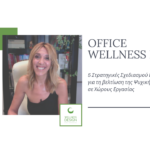
WellnessDesign™
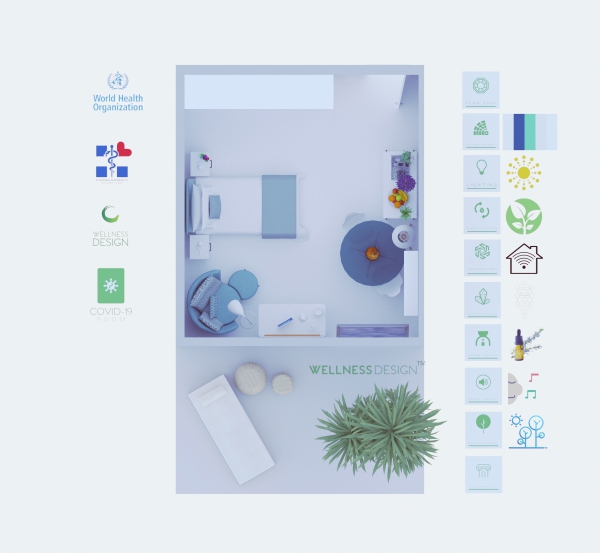
A simple, practical, holistic and innovative solution for a safe home isolation system for a covid-19 patient, so that they don’t carry the virus to the healthy members of their family when they have to remain under the same roof, while also supporting the patient’s mental health and well-being during their isolation which will assist in their gradual recovery and rehabilitation.
The room’s design meets the technical standards that have been approved by the World Health Organization regarding the at-home care for patients with COVID-19 presenting with mild symptoms and management of their contacts (WHO reference number: WHO/nCov/IPC/HomeCare/2020.3).
The inclusion in the room’s design, of the globally innovative wellness system Wellness Design™ that is founded by the Greek interior designer Elena Arsenoglou, and its 10 niche systems that support human’s mentality and well-being, grants the patient an environment that acts passively therapeutic for their health, by boosting their body system and mood and abiding by the requirements of WHO regarding the mental health and psychosocial considerations during the covid-19 outbreak (WHO/2019-nCov/MentalHealth/2020.1).
Step 1
Choosing the right room
Place the patient in a well-ventilated single room(i.e. with open windows and an open door). Limit the movement of the patient in the house and minimise shared space. Ensure that shared spaces(e.g. kitchen, bathroom) are well ventilated(keep windows open). Maintain a distance of at least 1 metre from the ill person.[1]
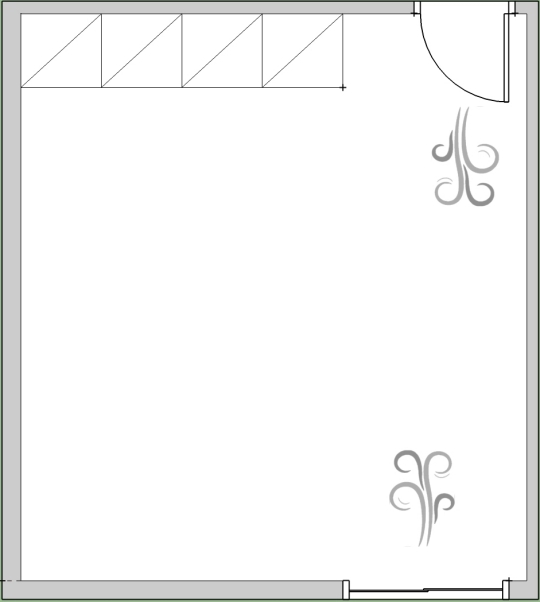
• If there is a well-ventilated room with ensuite bathroom, then you preferably go for it to limit the patient’s movement.
•If there is no room with ensuite bathroom, then you pick a well-ventilated room that is closer to a bathroom to limit the patient’s purposeless movements.
•If there are more than one bathrooms into the house, you grant the one with the best ventilation to the patient for exclusive use.
Step 2
Preparing the wellness room
The isolated patient’s room should provide basic everyday activities in order to limit their movements in the rest of the house and to minimise shared spaces. [1]
Also, it should offer the patient positive results for their mental health and well-being, be pleasant, interactive, and have good energy. [2]
These privileges will be passively received by the patient through the proper design and decoration of the room by applying the globally innovative wellness system WellnessDesign™.
The application of the ten specialized systems of Wellness Design™ in the configuration of the patient’s room, benefits their health, their good mentality, the positive energy in the room, and therefore the smooth and quick recovery and rehabilitation, in a way that abides by the requirements approved by World Health Organization for mental and psychological health during covid-19 outbreak. [2]
![]()

WellnessDesign™ | Traditional Chinese Medicine | Feng Shui
Layout and furnishing
The bed and the rest of the furniture are placed in the room according to the principles of Feng Shui, in order to ensure the best possible sleeping position and living for the patient.
Feng Shui is one of the 8 components of the Traditional Chinese Medicine (TCM) and alike all of these components, it aims to create harmony and find a balance between the 5 elements, as a form of prevention and treatment for humans. Feng Shui is the only part among the 8 of TCM that deals with material energy and through its principles it gives us clear information as to how that energy affects a person’s well-being. [2][4]
Positioning the Bed
- It has to be made sure that the patient has a comfortable bed with a good mattress.
- The bed should not be placed beneath a window, close to a balcony door or between a door and a window, to make sure the patient’s lungs are being protected by air streams.
- The bed should be placed in such a way so that the patient can see the door accessing the bedroom. This will make the patient feel safer by being able to see who enters the room. It also helps the caregiver to have an easier visual inspection of the patient.
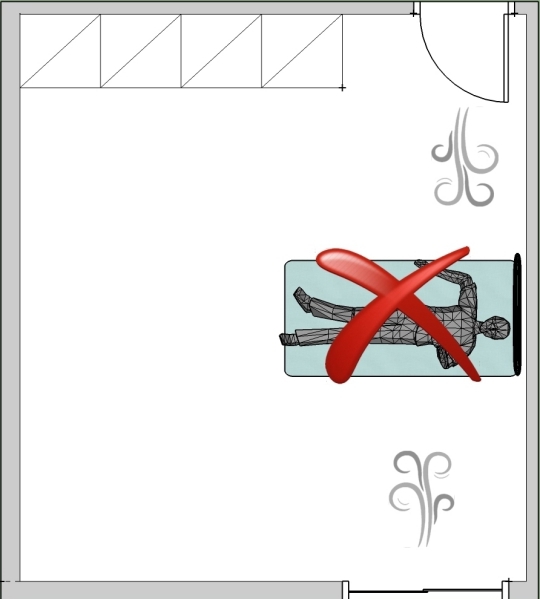
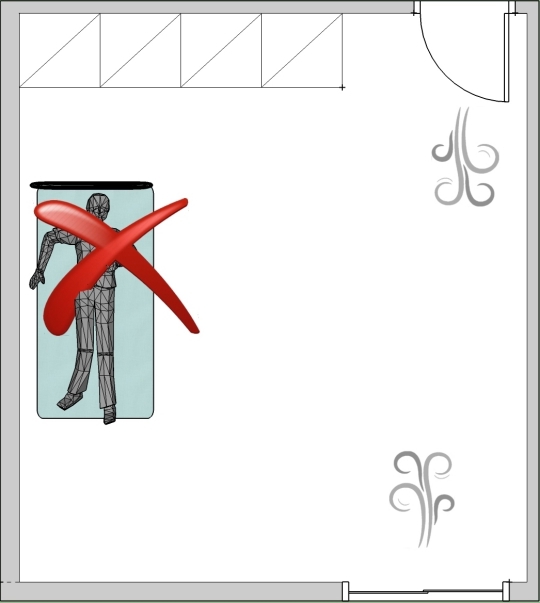
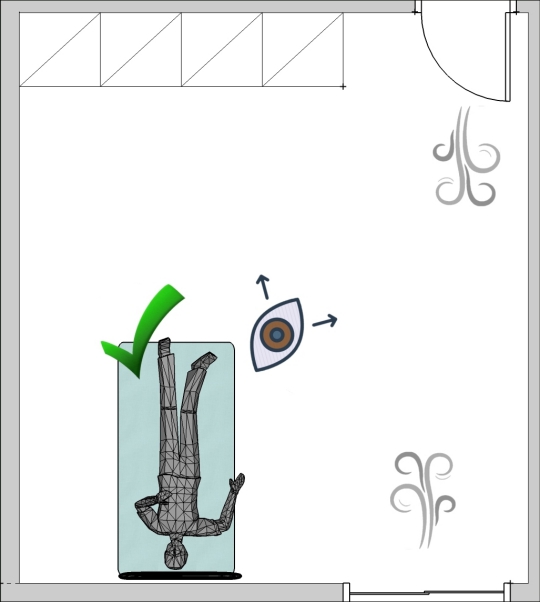
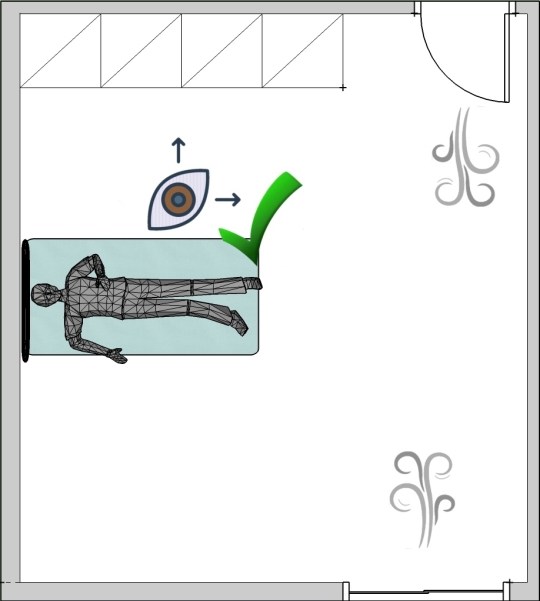
Bedside tables
- Spacious bedside tables should be placed by both sides of the bed for the patient to place their essential personal items. The bedside tables in both sides of the bed will provide a feeling of security and companionship, accompanied by their table lighting that will offer balance and warmth to the space.
Activity areas
Meal area
In order to limit the movement of the patient in the house and minimise shared space[1], a small kitchen area will be created within the patient’s room, to serve some of their basic needs and habits, like making coffee, tea or having a snack.
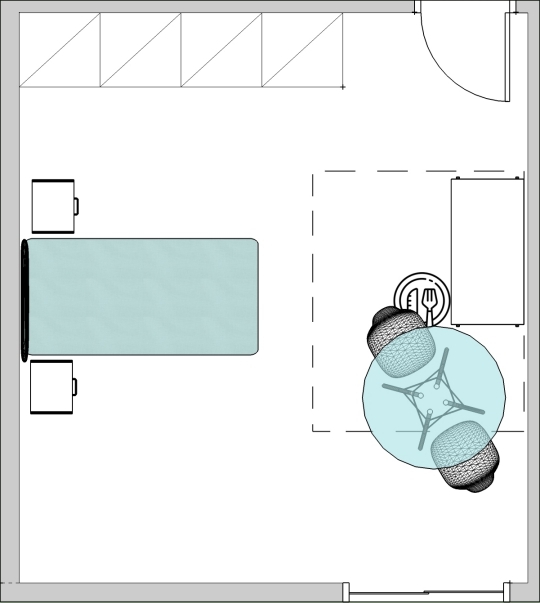
- For the kitchen space, a piece of wheeled furniture or any other available furniture could work.
- Near to the kitchen area, place a dining table with two chairs to serve patient’s meals. The presence of a second chair will help the patient mentally by giving them a sense of companionship. It could also be used by the patient to put their legs up.
- It is recommended that the kitchen area has visual contact with the door accessing the room, so the patient can be accompanied by someone at mealtime, in order to feel less alone.
Entertainment area
The maintenance of an active day to day life is of high importance during the time of isolation for the support of a good mental state. That could be exercise, social communications or simply doing something entertaining.[2]
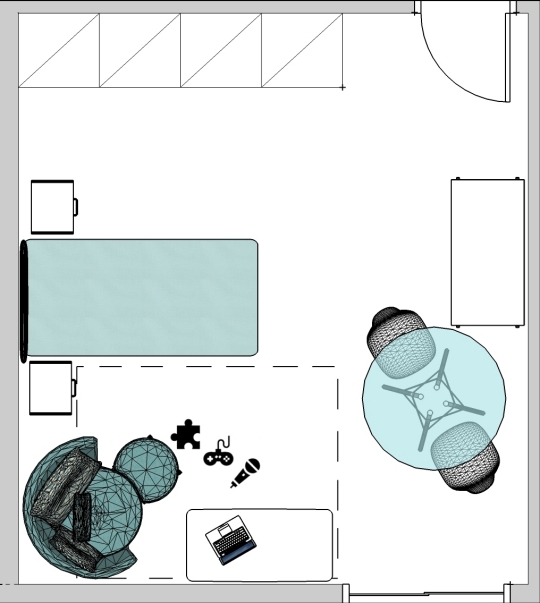
- For this purpose, a special entertainment area is created in the isolated patient’s room. That area could include music, television, books, a computer with internet access, and host any other activity the patient might enjoy on a personal level such as painting.
- If the space allows it, you can add a comfortable chair so the patient can have options as to where to sit during the day.
Utensils
- Use dedicated linen and eating utensils for the patient.
- Place a waste bin with a lid in the patient’s room, for gloves, masks and other waste generated during home care.
- Laundry bag for the patient’s clothes, bedlinen and bath and hand towel.
Decorating patient’s room

Wellness Design™ | Colour therapy
Chromotherapy or commonly known as colour therapy falls under the category of the Complementary and Alternative Medicine System (CAMS). It is one of the most successful ancient practices which is now gaining interest as a valid and effective science. Current studies concluded that chromotherapy is a natural way to cure various diseases worldwide.[5]
Concerning the psychological effects colour can have on a person, researches have shown that it does infact play an important role and could be very beneficial when used properly.
For many years, classic medicine has been practicing chromotherapy for the restoration of neonatal jaundice. Newborns suffering from neonatal jaundice, are placed in a room being lit by a special blue tinted light, which helps fasten their recovery.
For a patient’s room, colours that promote positive feelings and good health should be chosen. These colours are green, light blue and white.
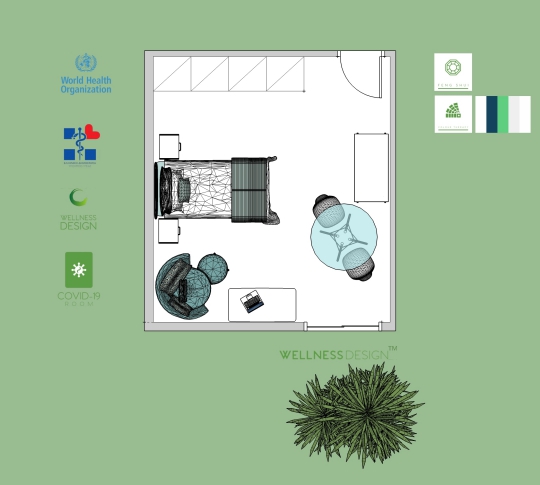
- Green is the most basic colour for chromotherapy and is also the safest one to be used. Green generates harmony in the body and spirit, relaxes, and works soothingly while also improving the mood.
- Light blue relaxes most people, has calming qualities, reduces arterial pressure, and helps deal with insomnia.
- White reflects all the light in a room, which results in it appearing much larger and cleaner.
- These colours could be applied to the bedsheets, the furniture, the curtains, and the patient’s clothes.
- If the room has access to a balcony or another outdoor space, place some large green plants outside the window. Researches have shown that patients who view green plants instead of buildings, recover faster, have a better mood, fewer complications, and need less medication. [11]

WellnessDesign™ | Lighting
Researches support daylight’s positive effects on good performance and health. [6]
Scientists at the Lighting Research Center (LRC), in Troy, N.Y., for example, have reported that daylit environments increase occupant productivity and comfort, and provide the mental and visual stimulation necessary to regulate human circadian rhythms.
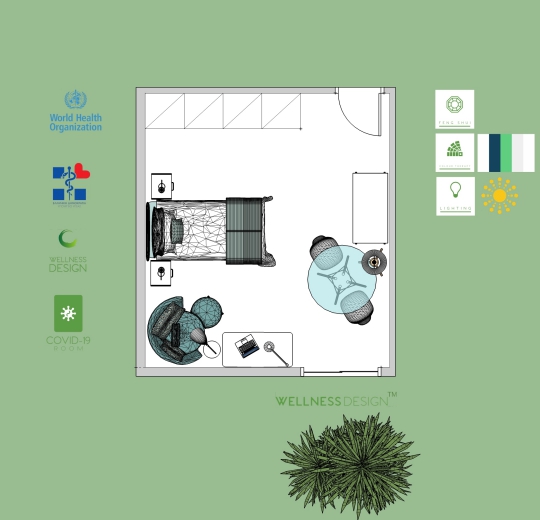
- Abundant natural light in the room will surely add to the patient’s mental health, and it is crucial to consider it during the process of choosing a room.
- Keeping the windows and the screens open throughout the day time.
- During the night, there shouldn’t be any blue light in the room (such as from the computer screen), because it can negatively impact the patient’s sleep.
Artificial lighting
- Table lamps with touch panels should be placed on the bedside tables and on the desk at the entertainment area.
- Adequate lighting should exist in the kitchen area and at the table that is used for the patient’s dining.
- Optionally, a floor lamp can be placed next to the lounge chair.

WellnessDesign™ | Purification
In the room of the patient natural ventilation of the space and high-quality indoor air is recommended.[7]
Air Conditioning
A special report according to air conditioning patients room was made by Greece’s Health Ministry’s representative, infectious disease specialist, Sotiris Tsiodras, who stated that the most reliable way to reduce the amount of viral particles in a house, is the well ventilation of the spaces. Referring to a study placed in China that refers to droplets in restaurants, the professor Tsiodras pointed out that if it is necessary to use an air conditioner it is important to avoid air recycling, the air should be going outside, especially when there is a case of the virus in the home. The windows should remain open for the air to refresh properly.
Plants
Indoor plants shouldn’t only be considered a decorative element of a room. In reality, plants can substantially contribute to the health of humans, drastically reducing anxiety levels, while at the same time absorbing indoor air contamination, according to studies. The studies selected plants that are recommended for air cleaning in indoor spaces.
You can use any of the plants mentioned below to help keep the air in the patient’s room clean and fresh.
- Red Ivy (Hemigraphis alternata)
- Common Ivy (Hedera helix)
- Wax plant (Hoya carnosa)
- Asparagus (Asparagus fern)
- Purple heart (Tradescantia pallida)
- Peace Lily (Spathiphyllum wallisii)
- Sansevieria (Sansevieria trifasciata)
- Ficus (Ficus benjamina)
- Bamboo Palm (Chamaedorea seifritzii)
- Marginata (Dracaena marginata)
Himalayan Salt Lamp
A lamp made of natural Himalayan salt can be placed in the room.
- Οne way that pink Himalayan salt lamps work is by releasing negative ions into the air in a process called air ionization. Studies suggest that air ionization has benefits, such as improved cognitive performance.
- Salt lamps can improve a person’s mood or help them sleep better. The dim, pinkish light can help create a soothing atmosphere that promotes relaxation.
All of these benefits can reduce stress by helping patient spend a few relaxing moments gazing at the soft light of the salt lamp.

WellnessDesign™ | Technology
Technology will be used simply and practically in the patient’s room, to provide automation without any specialized installation as to limit the surfaces the patient and their caregivers come in contact with.
- All lamps will be remote controlled.
- Next to the entrance of the room, there will be a hand sanitiser dispenser activated by photocell sensors.

WellnessDesign™ | Crystal Therapy
The beneficial properties of crystals have been known to humanity since the ancient years. Amongst others, the ancient Greeks, Egyptians, and Romans would use crystals for protection and healing. The sacred writings of the Indians explain the therapeutic properties of many crystals and how they can be used to treat diseases. Also, Traditional Chinese Medicine (TCM) often includes the use of crystals to heal.[8]
The patient’s room will be benefited by the presence of crystals that are known to provide mental and physical benefits.
Even if those benefits are working as a placebo, the results will be positive.
Clear Quartz
The main crystal that should be used is Clear Quartz.
Quartz is known as the “master healer” because of its ability to heal many ailments.
It also keeps and stores huge amounts of information. British researchers have managed to store information on quartz crystal with a lifespan of nearly 13 billion years.
This source of neutral energy is great for energy cleansing in the room of the patient. It may add more energy and charge during meditation or during breathing exercises.
- The stone could be placed on a bedside table, hung by a string in front of a window, or held by the patient.
Additional crystals that can be used
Amethyst
Amethyst provides the calming energy a patient needs for a quiet sleep and is the ideal crystal to be placed in a bedroom.
- The stone can be placed on the bedside table, under the patient’s pillow or hung by a string in front of a window.
Citrine
This bright, glowy stone illuminates bliss and light. It helps boost the mood when someone is feeling “down”.
- Place citrine crystal on the entertainment table and it can work as a reminder for the patient to use their inner happiness.
Aquamarine
Aquamarine is a beneficial crystal that can help with the restoration of mental health and creativity.
- The patient should keep the stone on them and place it on the entertainment table.
Black Tourmaline
This protective stone helps prevent the negative energy from entering the space or affect the person’s energy.
- Place the black tourmaline next to the bedroom’s door, near a window, or one in each of the four corners of the bedroom to protect the space from the negative energy.
Rose Quartz
Known as the crystal of love, rose quartz has the power to soothe the person and heal emotions.
- Place the rose quartz on a bedside table but also on the heart of the patient.
Tiger Eye
Tiger eye helps humans to feel present in their physical body, it strengthens the body and improves sports performance.
- The patient can hold the crystal on them when feeling weak or working out.

WellnessDesign™ | Aroma Therapy
Aromatherapy is the practice of using the natural oils extracted from flowers, bark, stems, leaves, roots or other parts of a plant to enhance psychological and physical well-being.
The inhaled aroma from these essential oils stimulates brain function. A form of alternative medicine, aromatherapy is gaining momentum. It is used for a variety of applications, including pain relief, mood enhancement and increased cognitive function.
There are a wide number of essential oils available, each with its own healing properties[9].
In the patient’s room will be used essential oils that boost the mood, tone mental health, soothe symptoms of a flu and clean the energy. Their use could be in the form of essential oil diffuser and oil burner.
- Clary sage
- Eucalyptus
- Geranium
- Lavender
- Lemon
- Peppermint
- Roman chamomile
- Rosemary

WellnessDesign™ | Sound Therapy
Human body consists 70-75% water.
Dr. Masaru Emoto discovered that the vibrations of words, sounds, and frequencies have a direct effect on the geometric structure of water crystals.
By playing different types of sounds, it has been found that a happy music has a positive effect on the geometric formation of water crystals, while a sad, depressing or heavy music (low vibrations) harms the formation of crystals.[10]
- For the patient’s room, choosing sounds and music that have positive results in the geometrical structure of water is of high importance, to support the health and well-being of the patient. Try cheerful music that is containing piano, violin, calm nature sounds, beautifully worded lyrics and solfeggio frequencies like MI 528Hz.

WellnessDesign™ | Outdoor Therapy
Sun and Nature, human’s allies for good health and well-being. [11]
- If the room has a balcony or garden, it’s very beneficial for the patient to sit by the sun and nature for 15-20 minutes a day.
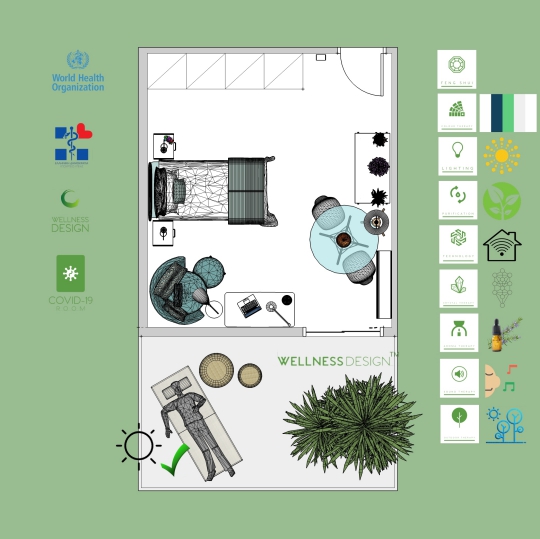
Sunshine
The best-known benefit of sunlight is its ability to boost the body’s vitamin D supply.
At least 1,000 different genes governing virtually every tissue in the body are now thought to be regulated by vitamin D3.
Sun exposure lowers blood pressure, improves bone health, brain function and sleep quality, eases mild depression, enhances the immune system and much more.
Sunshine does have a lot of benefits, but it’s still the number one cause of skin cancer. Experts recommend no more than 15 to 20 minutes of direct sunlight daily for a healthy adult. After that, apply sunscreen with a minimum Sun Protection Factor (SPF) of 30.
Nature & Garden
Findings from several studies have converged in indicating that simply viewing certain types of nature and garden scenes significantly ameliorates stress within only five minutes or less. Further, an amount of research has found that viewing nature for longer periods not only helps to calm patients, but can also foster improvement in clinical outcomes.
Well-designed gardens not only provide restorative and pleasant nature views, but also can reduce stress and improve clinical outcomes through other mechanisms such as increasing access to social support, and providing opportunities for positive escape from stressful clinical settings.

WellnessDesign™ | Ancient Greek Εὖ Ζῆν
For ancient Greeks, Εὖ Ζῆν, was the most important good and translates into the art of living good (bliss), while also requiring achieving a good physical and mental health, which leads to the improvement of the quality of life on all parts, finally reaching bliss.
The term comes from the ancient greek adverb εὖ which means good and the also ancient greek ζῆν (indefinite present tense of the verb ζῶ) that declares the state of surviving, life.
By applying the innovative wellness system Wellness Design™ in the covid-19 room, you manage to create an Εὖ Ζῆν space for the patient that will help them have a smooth and quick recovery, in a pleasant and therapeutic environment.
The room will also be inspired by the wisdom of the ancient Greek philosophers, as to lead the consciousness and the intentions of the patient and their caregivers in a state of love and peace, through the quotes of ancient Greek philosophers that will be placed in the room.
Dr. Masuru Emoto discovered that the vibrations of words have a direct effect on the geometric structure of water crystals. By simply labeling with words, the crystalline formation of water was found to respond positively to words like “love” and “peace,” and to respond negatively to words like “hate” and “war,” as if the water knew the meaning of these words.
Other experiments were conducted using human thought, prayer and intention, and the same results were obtained. It has been found that human consciousness, prayer, and intention have a direct effect on the crystal composition of water molecules.
- It is suggested that a noticeboard is placed in the room to work as a point of inspiration, motivation, and positive reminder for mindful meditation [12] for the isolated patient. On the noticeboard, there will be quotes by ancient Greek philosophers that promote these purposes and can be accompanied by pleasant images also. For example:
«Love is the cause of unity of all things»
— Aristotle
«With the first touch of love everyone becomes a poet»
— Plato
- A quote that “speaks” to the consciousness of the patient’s caregiver can be placed on the door of the room, to give them courage. For example:
«What makes you sad friend. Give me a part of your pains, to relieve you»
— Socrates
«Love one another»
— Plato
Love, Health and Blessing to all humans
Elena Arsenoglou

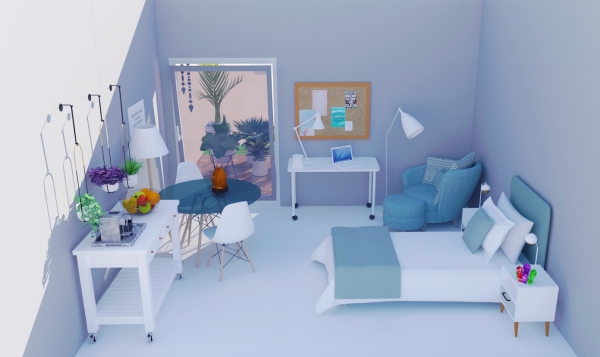
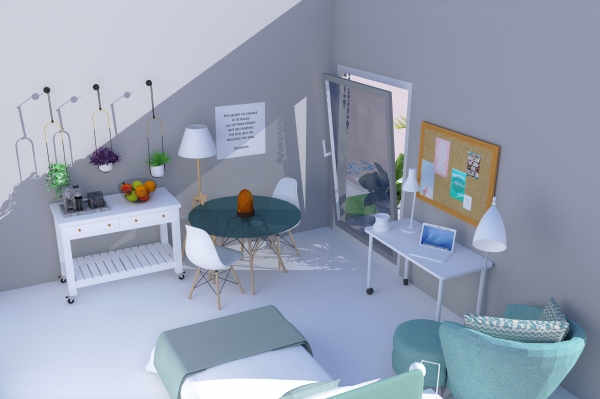
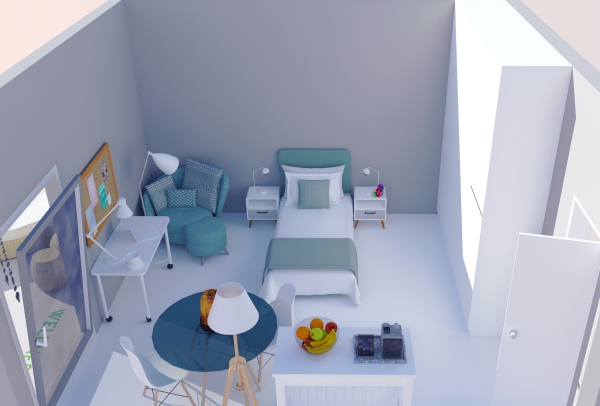
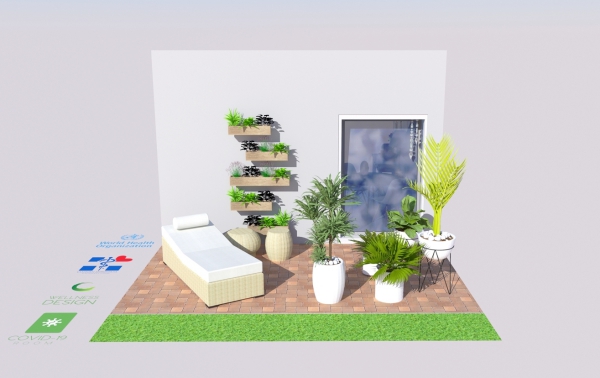
COVID-19 | ROOM
WellnessDesign™
Notice: Patient and household members should follow World Health Organization guidance about their personal hygiene and daily cleaning that are mentioned at WHO/nCov/IPC/HomeCare/2020.3
References
Technical standards approved by a person or team in the medical profession
[1] World Health Organization. Home care for patients with COVID-19 presenting with mild symptoms and management of their contacts: interim guidance, 17 March 2020. Geneva WHO reference number: WHO/nCov/IPC/HomeCare/2020.3
[2] World Health Organization 2020, Mental Health and Psychosocial Considerations During COVID- 19 Outbreak, accessed 19 March 2020, https://www.who.int/docs/default- source/coronaviruse/mental-health- considerations.pdf.
WHO/2019-nCoV/MentalHealth/2020.1
[3] Ministry of Health Greece https://www.moh.gov.gr/articles/ministry/grafeio-typoy/press-releases
[4] Traditional Chinese Medicine – Feng Shui
- Wind and water: Feng Shui as complexity science https://www.researchgate.net/publication/330554330
- Traditional Chinese Medicine: Scientific Basis for Its Use https://books.google.gr/books?id=TGsoDwAAQBAJ&lpg=PA1&ots=AP80zhCipr&dq=scientific%20evidence%20feng%20shui%20for%20health&lr&hl=el&pg=PP1#v=onepage&q=scientific%20evidence%20feng%20shui%20for%20health&f=false
- Research in Scientific Feng Shui and the Built Environment. Michael Y. MAK, Albert Ting-pat SO – City University of Hong Kong Press, ISBN:978-962-178-4
- American Academy of Sleep Medicine. “Television Watching Before Bedtime Can Lead To Sleep Debt.” ScienceDaily. ScienceDaily, 8 June 2009 <www.sciencedaily.com/releases/2009/06/090608071941.htm>.
- Challenging Ways Technology Affects Your Sleep https://www.sleep.org/articles/ways-technology-affects-sleep/
- Impact of Windows and Daylight Exposure on Overall Health and Sleep Quality of Office Workers: A Case-Control Pilot Study https://www.ncbi.nlm.nih.gov/pmc/articles/PMC4031400/
- Can Chinese Medicine Be Used for Prevention of Corona Virus Disease 2019 (COVID-19)? A Review of Historical Classics, Research Evidence and Current Prevention Programs Available online at link.springer.com/journal/11655 Journal homepage: www.cjim.cn/zxyjhen/zxyjhen/ch/index.aspx
- Wang W Y, Yang J. An overview of the thoughts and methods of epidemic prevention in ancient Chinese
- Joseph N, Lu G. Hygiene and preventive medicine in ancient China. J History Med All Sci 1962;17:429-478.
- People at risk of hoarding disorder may have serious complaints about sleep https://www.eurekalert.org/pub_releases/2015-06/aaos-par060815.php
- Jill Poulston, Auckland University of Technology and New Zealand Tourism Research Institute, New Zealand https://openrepository.aut.ac.nz/bitstream/handle/10292/1628/poulston%20paper2%20-%20feng%20shui.pdf?sequence=2&isAllowed=y
- Feng Shui and the Restructuring of the Hospital Corporation: A Call for Change in the Face of the Medical Error Epidemic https://pdfs.semanticscholar.org/89be/50fc2846f98cd610792f901187980fed7ed5.pdf
[5] Colour therapy
- Critical Analysis on the Effectiveness of Chromo therapy American Research Journal of Pharmacy Original Article ISSN 2380-5706 Volume 1, Issue 2, 2015 Available from: https://www.researchgate.net/publication/287196164_Chromo_therapy-_An_Effective_Treatment_Option_or_Just_a_Myth_Critical_Analysis_on_the_Effectiveness_of_Chromo_therapy
- Health Benefits of Gardens in Hospitals – Roger S. Ulrich, Ph.D. Available at: https://www.researchgate.net/publication/252307449
- COLOR IN HEALTHCARE ENVIRONMENTS By Ruth Brent Tofle, Ph.D. Benjamin Schwarz, Ph.D So-Yeon Yoon, MA Andrea Max-Royale, M.E.Des Published in 2003 by the Coalition for Health Environments Research (CHER) Available from: www.CHEResearch.org
- Mi Kyoung Kim , Sung Don Kang (2012), Effects of Art Therapy Using Color on Purpose in Life in Patients with Stroke and Their Caregivers, Younsei Medical Journal [online] vol 54 (1).p .15-20 Available from: http://europepmc.org/backend/ptpmcrender.fcgi?accid=PMC3521264&blobtype=pdf
- Bo`O Vojnikovi (2010) Chromotherapy Of Macular Degeneration With Transitions Lenses And Green-Yellow Medical Filters And Special Programme For Psycho Organic Disturbances, Collegium Antripologicum [Online] Vol 34(2) P. 89-93 Available From: http://hrcak.srce.hr/index.php?show=clanak&id_clanak_jezik=79042
- Dr. Maqsood Azeemi, (2007) Health And Colors In “Khawaja Shamsuddin Azeemi Color Therapy”, Peshawar Cantt.By Burkhiya Education Foundation (Redg.), pg no:26-31 available from: http://www.souldesigns.net/iq_blog/color_therapy.pdf
- Lexiyoga (2014). Colour Healing Available from: http://www.lexiyoga.com/colour-healing
- Color Me Heathy.com (2009), Let color put the life back in your life Available from: http://www.color-me-healthy.com/psychology.html
- Amara Holistic Well Being (2005), Colour Therapy Available from: http://www.amaraholisticwellbeing/colortherapy.html
- Zena O‟connor, (2011), Colour Psychology And Colour Therapy: Caveat Emptor, Color Research & Application,[online] vol: 36, issue 229–234 Available from: http://onlinelibrary.wiley.com/enhanced/doi/10.1002/col.20597/
- Eu natural (2003) Color Therapy For Sleep [online] Available from: http://eunatural.com/color-therapy-for-sleep/
- Samina T. Yousuf Azeemi, Syed Mohsin Raza, Masoom Yasinzai, (2008) ,Colors as Catalysts in Enzymatic Reactions Journal Of Acupuncture And Meridian Studies [online] Vol 1, Issue 2 , p 139-142 Available From: http://www.jams-kpi.com/article/S2005-2901(09)60034-0/abstract
- Sarah Dray, (2014) livestrong.com, Colortherapy For Weight Loss [online] Available from: http://www.livestrong.com/article/190776-color-therapy-for-weight-loss/
- E. Ewing, G. Ewing1, E.U. Nwose (2009) Migraine Can Be Managed With Virtual Scanning: Case Report, The Open Complementary Medicine Journal,[online] vol 1.p 16-18. Available from: http://benthamopen.com/toaltmedj/articles/V001/16TOALTMEDJ.pdf
- ICBS (2007) Migraine headaches, holisticonline.com [online] Available from:http://holisticonline.com/Remedies/migraine/mig_color.htm
- Dr Linda Mayer and Prof Rashid Bhikha, (2014), The Historical Significance of Colour, Tibb institute – A Science of Medicine The Art Of Care, [onine] part:2 p1-11 Available from:http://www.tibb.co.za/articles/Part-2-Historical-significance-of-colour.pdf
- Hari Om Gupta,(2007), The Healing Powers Of Chromotherapy Using Colors To Cure Diseases, [online] New Delhi, Sterling Publishers. Available from: http://books.google.com.pk/books id=HqFgj4KBsDsC&printsec=frontcover&source=gbs_ge_summary_r&cad=0#v=onepage&q&f=false
- Samina T. Yousuf Azeemi. S. Mohsin Raza, Masoom Yasinzai, Abdul Samad, (2009), Effect of Different Wavelengths on Superoxide Dismutase, Journal of Acupuncture and Meridian Studies [online] vol: 2(3) p.236-238 Available from: http://www.sciencedirect.com/science/article/pii/S2005290109600601
- Elkina TN, Zakharova (2013),The Experience With The Application Of Selective Polarized Chromotherapy In The Clinical Practice, Medline Journal [Online] Vol:1 P.7-12 Available From: http://www.biomedsearch.com/nih/experience-with-application-selective-polarized/24640656.html
- J. Weinzirl, M. Wolf, P. Heusser, M. Nelle, U. Wolf (2011) Effects of Changes in Colored Light on Brain and Calf Muscle Blood Concentration and Oxygenation, The Scientific World Journal, [online] vol 1. p. 1216-1225. Available from: http://www.hindawi.com/journals/tswj/2011/370149/abs/
- Ilse Truter (2006) COLOUR THERAPY “Using the energy of light in controlled „doses‟to affect healing” SA Pharmaceutical journal [online] Department of Pharmacy, Nelson Mandela Metropolitan University, vol 73 (4) 56-58, Available from: http://reference.sabinet.co.za/webx/access/electronic_journals/mp_sapj/mp_sapj_v73_n4_a20.pdf
- Autonomic Nervous System Responses to Viewing Green and Built Settings: Differentiating Between Sympathetic and Parasympathetic Activity doi: 10.3390/ijerph121215026
[6] Lighting
- Daylighting Pattern Guide, by New Buildings Institute with the University of Idaho and the University of Washington. Available at patternguide.advancedbuildings.net
- Daylighting, by the Illuminating Engineering Society, uploaded February 2012. Available at youtube.com/user/IES1906
- Five narrated presentations, subtitled Podcast 01 to Podcast 05, cover basic daylighting concepts and design strategies. eLAD Body of Knowledge, by the U.S. Department of Energy, last modified Aug. 5, 2012. elad.su-per-b.org
- Approved Method: IES Spatial Daylight Autonomy (sDA) and Annual Sunlight Exposure (ASE) , by the Illuminating Engineering Society (IES), 2013.
- Daylighting Design in the Pacific Northwest , by Christopher Meek and Kevin Van Den Wymelenberg, University of Washington Press, 2012.
- “The Benefits of Daylight Through Windows,” by Peter Boyce, Claudia Hunter, and Owen Howlett, Lighting Research Center, 2003. This literature review examines the effects of daylight on human health and worker performance.
[7] Purification
Air conditioning
- https://eody.gov.gr/wp-content/uploads/2020/05/klimatistika-covid19.pdf
- https://www.moh.gov.gr/articles/ministry/grafeio-typoy/press-releases
- iefimerida.gr – https://www.iefimerida.gr/ellada/tsiodras-dyskolo-thema-ta-klimatistika
- https://www.epa.gov/indoor-air-quality-iaq/improving-indoor-air-quality#Source_Control
Plants
- Volatile Organic Compounds Emanating from Indoor Ornamental Plants DOI: https://doi.org/10.21273/HORTSCI.44.2.396https://www.researchgate.net/search?q=indoor%20plants%20and%20health
- https://link.springer.com/article/10.1023/B:WATE.0000038896.55713.5b
- A Study of Interior Landscape Plants for Indoor Air Pollution Abatement https://ntrs.nasa.gov/archive/nasa/casi.ntrs.nasa.gov/19930072988.pdf
- Planting Healthier Indoor Air doi: 10.1289/ehp.119-a426 https://www.ncbi.nlm.nih.gov/pmc/articles/PMC3230460/
- Wolverton BC. How to Grow Fresh Air: 50 House Plants that Purify Your Home or Office. New York, NY:Penguin Books (1997)
- DOI 10.1007/s11356-014-3240-x Ornamental potted plants remove volatile organic compounds from indoor air | Majbrit Dela Cruz & Jan H. Christensen & Jane Dyrhauge Thomsen & Renate Müller https://greenplantsforgreenbuildings.org/wp-content/uploads/2014/09/Dela-Cruz-2014-review-on-phytoremediation-with-indoor-plants-2.pdf
- 2006 Cambridge University Press NAMNI GOEL (a1) and GLENDA R. ETWAROO (a1) DOI: https://doi.org/10.1017/S0033291706008002
Himalayan Salt
- Exposure to Air Ions in Indoor Environments | Int J Environ Res Public Health. doi: 10.3390/ijerph121114301 PMCID: PMC4661648 PMID: 26569277
- Exposure to illuminated salt lamp increases 5-HT metabolism: A serotonergic perspective to its beneficial effects Hajra Naz* and Darakhshan J Haleem Neurochemistry and Biochemical Neuropharmacology Research Unit, Department of Biochemistryhttp://www.pjbmb.org.pk/images/PJBMBArchive/2010/PJBMB_43_2_Jun_2010/13.pdf
[8] Crystal Therapy
- Dr. Emoto discovered that the vibrations of words, sounds and frequencies have a direct effect on the geometric structure of water crystals . doi: 10.1186/1472-6882-9-32 https://www.ncbi.nlm.nih.gov/pmc/articles/PMC2739841/
- https://www.lesechos.fr/2016/02/ce-petit-disque-de-quartz-peut-stocker-des-donnees-pendant-13-milliards-dannees-202791 doi: 10.1080/00029157.2012.74043 https://www.ncbi.nlm.nih.gov/pmc/articles/PMC3602922/
- The placebo effect: illness and interpersonal healing doi: 10.1353/pbm.0.0115
[9] Aroma Therapy
- Lee KB, Cho E, Kang YS. Changes in 5-hydroxytryptamine and cortisol plasma levels in menopausal women after inhalation of clary sage oil. Phytother Res2014;28(11): 1599-605
- Essential oils used in aromatherapy: A systemic review https://reader.elsevier.com/reader/sd/pii/S2221169115001033?token=09E80F55EB8C09787EFBFAF8F16230E0DCE9F30ADEFCBC2572357EEFD29DE6585B19A21DE00A4C18C27DB3CA180DA7DA
[10] Sound Therapy
- DR. MASARU EMOTO DISCOVERS HOW ENERGY INFLUENCES GEOMETRIC STRUCTURE
Messages from Water, Vol. 1 (June 1999), Hado Publishing
Messages from Water, Vol. 2 (November 2001), Sunmark Pub.
The Hidden Messages in Water (April 2004 Eng., 2001 Jap.),
The Message from Water III: Love Thyself (January 2006), published by Hay House
Water Crystal Healing: Music & Images to Restore Your Well Being (17 October 2006), published by Atria Books
The Shape of Love: Discovering Who We Are, Where We Came From, and Where We are Going, Doubleday, 2007.
- Effects of choir singing or listening on secretory immunoglobulin A, cortisol, and emotional state. https://www.ncbi.nlm.nih.gov/pubmed/15669447
[11] Outdoor Therapy
- Benefits of Sunlight: A Bright Spot for Human Health PMID: 18414615 https://www.ncbi.nlm.nih.gov/pmc/articles/PMC2290997/
- Does D Make a Difference?” in SA Mind 20, 6, 14 (November 2009) doi:10.1038/scientificamericanmind1109-14
- Effect of sunlight and season on serotonin turnover in the brain. PMID: 12480364 DOI: 10.1016/s0140-6736(02)11737-5 https://www.ncbi.nlm.nih.gov/pubmed/12480364
- Health Benefits of Gardens in Hospitals – Roger S. Ulrich, Ph.D. Available at: https://www.researchgate.net/publication/252307449
- Nature experience reduces rumination and subgenual prefrontal cortex activation https://doi.org/10.1073/pnas.1510459112
- Autonomic Nervous System Responses to Viewing Green and Built Settings: Differentiating Between Sympathetic and Parasympathetic Activity doi: 10.3390/ijerph121215026
- The relative benefits of green versus lean office space: Three field experiments. https://doi.org/10.1037/xap0000024
[12] Ancient Greek Εὖ Ζῆν
- Dr. Esther Sternberg, Healing Spaces: The Science of Place and Well-Being DOI: 10.1177/193758671100400213
- Mindfulness meditation helps fight insomnia, improves sleep https://www.health.harvard.edu/blog/mindfulness-meditation-helps-fight-insomnia-improves-sleep-201502187726
- Mindfulness Meditation and Improvement in Sleep Quality and Daytime Impairment Among Older Adults With Sleep Disturbances https://jamanetwork.com/journals/jamainternalmedicine/fullarticle/2110998
- The Connection Between Art, Healing, and Public Health: A Review of Current Literature doi: 10.2105/AJPH.2008.156497


 Ελληνικά
Ελληνικά
